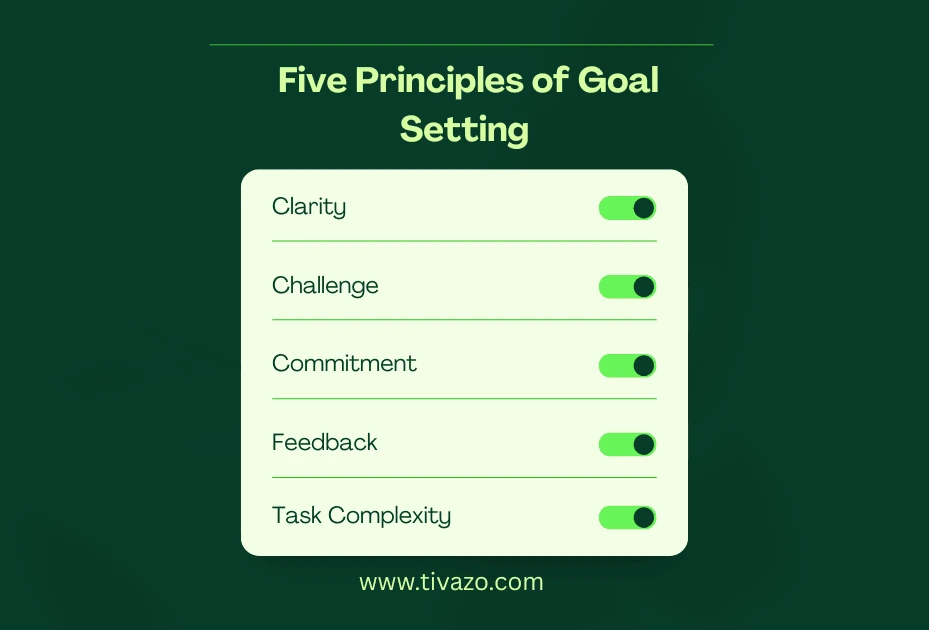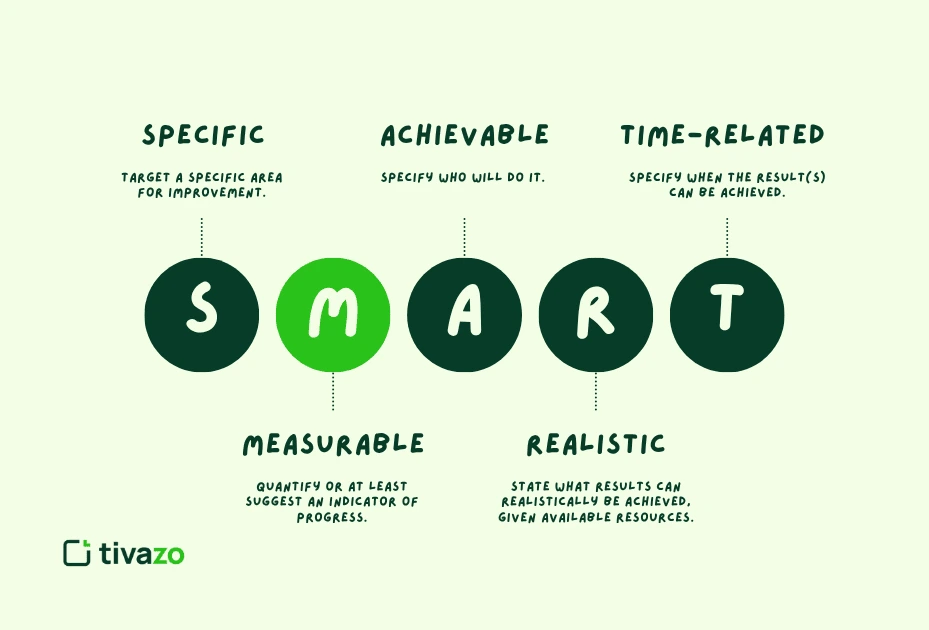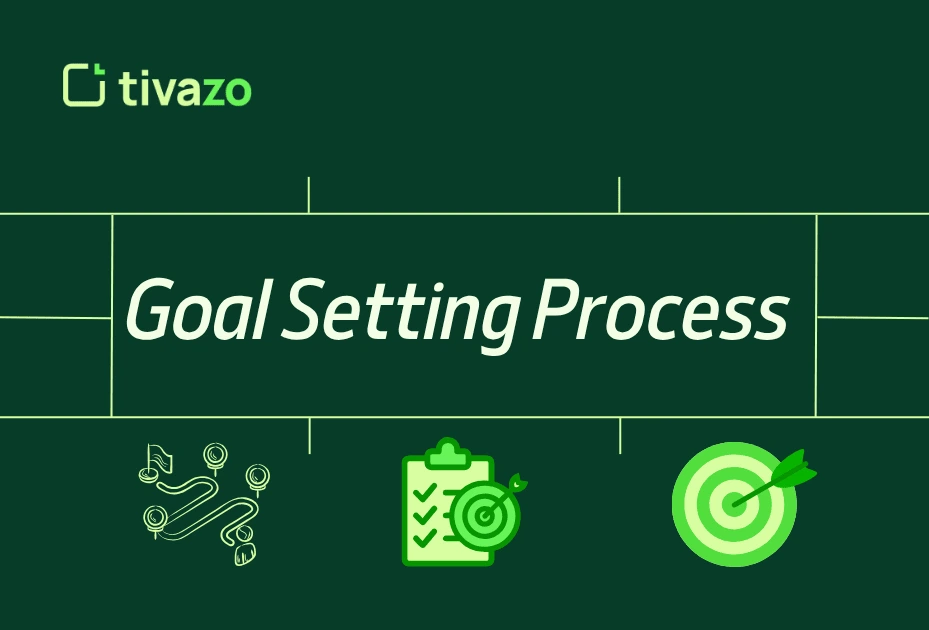Ever feel like your dreams are stuck in your head and never make it to real life? If yes, you’re not alone, and that’s where the goal setting process comes in.
Whether it’s landing your dream job, starting a side business, or finally sticking to a fitness routine, the difference is how you approach setting your goals. The right goal setting process doesn’t just make you dream, it makes you do.
In this blog post, we’re breaking down simple, successful steps to get the goal setting process just right. No malarkey, no technical terms, just plain, usable advice to turn your list of goals into tangible successes. If you’re ready to stop procrastinating and get on with it, you’re in the right place. Let’s get started!
You May Also Like: Best Goal Setting Apps: Free & Premium Tools to Crush Your Goals
Key Highlights:
- Goal-Setting Process
- Importance of the Goal-Setting Process
- Principles of Goal-Settings
- Types of Goal-Setting Process
- Goal-Setting Process Differentiation
- List of Goals to Achieve
- Role of Digital Detox
- Role of Emotions
What is the Goal Setting Process?
The goal setting process is a step-by-step plan that helps you reach what you want in life. Think of it like a roadmap. If you don’t know where you’re going, how will you ever get there? The goal setting process shows you the way. You pick a goal, break it down, and follow each step until you make it happen.
When you follow the goal setting process, you’re more likely to stay on track. You feel more focused and confident. Whether it’s getting better at school, learning a new skill, or saving money, this process works for everything.
Why is Goal Setting Important?
Imagine waking up every day and not knowing what to do. That’s what life feels like without goals. The goal setting process gives your day direction. It helps you grow, stay motivated, and keep moving forward.
Goal setting makes things easier because you have a clear plan. It also feels great to check things off your list. You feel proud, happy, and ready for the next challenge. Plus, your chances of success go way up when you have a clear list of goals.
You May Als Like : 15 Effective Goals to Achieve at Work for Career Success
What Are the Five Principles of Goal Setting?

When it comes to turning your dreams into goals, and your goals into reality, the goal setting process isn’t something you want to wing. There’s a reason some people achieve what they set out to do while others get stuck halfway, it’s because successful people follow a clear structure. That structure includes five simple but powerful principles that guide the way. These principles help you stay focused, motivated, and on track from start to finish.
Let’s break them down:
Clarity
Be super clear about what you want. Saying “I want to be better” isn’t helpful. A clear goal sounds like “I want to finish one book a month” or “I want to save $500 in 3 months.” The clearer your goal, the easier it is to chase.
Challenge
Pick a goal that pushes you out of your comfort zone. If it feels too easy, it won’t excite you. A little challenge keeps things interesting and helps you grow.
Commitment
You need to really want it. Remind yourself daily why this goal matters to you. When things get tough, your commitment will carry you through.
You May Also Like: 6 Best Professional Development Activities for Growth
Feedback
Check in with yourself. Are you getting closer? What’s working? What’s not? Feedback helps you adjust your path.
Task Complexity
If the goal is big, break it down into smaller steps. Don’t try to do it all at once; it gets overwhelming. One small step at a time is the secret.
These five principles are like the foundation of a strong house; you need them to build something lasting. When you follow them, the goal setting process becomes less stressful and more rewarding. It’s not about doing everything at once; it’s about doing the right things, one step at a time. Stick to these principles, and your goals won’t just stay on paper; they’ll come to life.
Types of Goal Setting Process
Let’s be honest, setting goals isn’t a one-size-fits-all thing. The truth is, the goal setting process can look different depending on where you are in life or what you’re trying to achieve. Some goals are small and quick, while others take years and lots of patience. The good news? No matter what your dream is, there’s a style of goal setting that fits just right. Below are five common types of goal setting processes that you can actually use, like, starting today.
1. Short-Term Goal Setting
Short-term goals are the quick wins in life. These are the goals that you can reach within a few days or maybe a month. Think: “I want to clean my messy desk this weekend” or “I want to finish a book I started.” The goal setting process for short-term goals helps you stay focused and take fast action.I like writing my short-term goals on sticky notes and putting them on my wall, it feels so good to take one down after I’ve nailed it. This type of goal setting keeps your energy high and builds momentum for bigger things.
You May Also Like: 15 Short Term Career Goals to Boost Your Success
2. Long-Term Goal Setting
Now let’s talk about the big stuff. Long-term goals are dreams that take time, sometimes months or even years. Want to graduate college? Start your own business? Travel the world? That’s long-term goal setting. The goal setting process here is all about patience, planning, and consistency. You won’t see results right away, but the progress is totally worth it. I remember when I wanted to learn graphic design. It took me over a year of online classes, late-night practice, and lots of coffee, but I got there. And trust me, reaching a long-term goal feels like magic.
3. SMART Goal Setting

The famous SMART goals, this one’s a classic for a reason. SMART stands for
-Specific
-Measurable
-Achievable
-Realistic
-Time-bound
It’s like putting your goal through a reality check. The SMART goal setting process makes sure you’re not setting yourself up for failure. Say you want to “get fit”, okay, but what does that mean? A SMART version would be, “I want to work out 3 times a week for the next 2 months.” See the difference? This type of goal setting process gives your dreams structure. It’s how you go from “I wish” to “I will.”
4. Personal Goal Setting
These are your goals. No school, no boss, no deadlines, just joyful goals. Maybe you’d like to play guitar, read more books, or finally start each day’s journaling. The art of personal goal setting is all about growth, loving yourself, and doing things that bring you joy. A few months ago, I set a goal to meditate every day for 10 minutes. Was it life-changing? Sort of, sure. I was more casual, more focused, and proud that I waited it out. These type of goals remind you that your energy and time are important, too.
5. Professional Goal Setting
Never keep in mind the professional side of life. Professional goals guide you to grow in the workplace or profession. It could be promotion, learning a new skill, or starting an own small venture. Professional goal setting helps you get directions at the workplace and keeps you focused on progress. I once set a goal to lead my first team project, and when it actually happened, it felt amazing. You’re not just clocking in and out, you’re building something bigger for your future.
Each of these types of goal setting process plays a different role in your life. You might use one, or you might use all five at the same time, and that’s okay! The beauty of setting goals is that it’s personal. What matters most is that you start. Whether it’s a tiny win or a lifelong dream, the goal setting process helps you move forward. One step, one goal, one day at a time. Keep going, you’ve got this.
Difference Between Types of Goal Setting Process
Here’s a simple and clear table that shows the differences between types of goal setting process:
| Factor | Short-Term Goals | Long-Term Goals | SMART Goals | Personal Goals | Professional Goals |
|---|---|---|---|---|---|
| Time | Achieved quickly (days to a few weeks) | Takes longer (months or years) | Can be short or long-term depending on how it’s set | Flexible timeline based on personal choice | Usually tied to work deadlines or career plans |
| Focus | Daily tasks or quick wins | Big dreams or future plans | Focused and specific to one clear objective | Self-improvement or personal happiness | Career growth, job performance, or skill-building |
| Structure | Informal and flexible | May need a step-by-step plan | Follows the S.M.A.R.T. format (Specific, Measurable, etc.) | Can be casual or structured as needed | Often aligned with professional development plans |
| Outcome | Quick motivation and small achievements | Long-lasting and meaningful results | Clear, trackable outcomes | Personal satisfaction and growth | Tangible work or career achievements |
Top 10 List of Goals to Achieve
Starting your goal setting journey can be exciting but also a bit intimidating. The good news is, I’ve put together a list of 10 achievable goals to inspire you! These goals are perfect for anyone, whether you’re new to goal setting or already working towards bigger dreams. Let’s take a look at these simple, yet powerful goals you can set for yourself.
1. Improve Physical Health
One of the greatest things to start off with is your health. Regular exercise is a necessity, but it doesn’t have to be anything drastic. Even 30 minutes of daily exercise can get you feeling better, more energetic, and on top of the world. If it’s just a walk, some light yoga, or even dancing to that one song that you love, find what’s best for you! When you begin to pay attention to your body, you’ll see how it benefits other areas of your life as well, and it is an important part of the goal setting process. Keep in mind, consistency is the key, so set small, attainable goals, and watch your health goals expand!
2. Eat Healthier
Changing your eating habits can seem overwhelming, but it doesn’t have to be. A simple, powerful goal is to start cutting down on junk food and sugary snacks. Try swapping out chips for veggies or sugary sodas for water. You’ll be amazed at how small changes can make a big difference. Start by setting realistic goals—maybe aim for 2-3 healthy meals a week and gradually increase. By following this goal setting process, you’ll develop healthier habits that stick. A healthier diet will improve not just your physical health, but your mood and productivity too. It’s all about taking one small step at a time.
3. Save Money
Another strong goal is learning how to manage your finances. Saving money is one of those things that can very easily fall by the wayside, but it’s essential to do in order to create a solid future. Begin with a savings account and an automatic deposit from your main account. Even $5 or $10 a week will add up fast over time. You’ll be amazed at how much you can save by following this simple goal setting process.
Watching your savings account grow is one of the greatest feelings, and it’ll give you peace of mind knowing that you’re prepared for emergencies or big-ticket purchases.
4. Read More

If you’re someone who loves learning, then setting a goal to read more is a perfect fit. A great way to start is by committing to reading one book each month. It’s all about making reading a regular part of your routine. Whether it’s fiction, self-help, or anything in between, reading expands your mind and improves your vocabulary.
Plus, it’s a great way to relax after a busy day. In setting goals, this goal motivates self-growth and maintains you energized and motivated. Attempt to make a list of books you’ve been eager to read, and use that list as a roadmap to your reading objectives!
5. Learn a New Skill
There is always something new to learn, so why not set yourself the challenge of acquiring a new skill? It could be painting, it could be cooking, or coding. Choose something you would like to do and puzzle you. Begin with small steps that are simple to achieve, and you will be motivated. The goal of setting goals to acquire a new skill is about being consistent. Invest 20-30 minutes two times a week, and you will see progress in the long term. The joy of having acquired something new will encourage you to keep going, and you will be proud of what you’ve accomplished. Additionally, acquiring new skills sharpens your mind and makes you more confident!
You May Also Like: 10 Best Career Development Topics to Grow at Work in 2025
6. Build a Morning Routine
Having something in mind to implement a morning routine can be life-changing. Waking up early and starting off your day with a purpose is a great way to set yourself up for success. Whatever it is, writing in your journal, making your plan, or doing a quick workout, having a routine in the mornings makes it easier to stay on track and be productive during the day. The act of creating your goals for a morning routine is all about finding what you can do and sticking to it.
Once you’ve established your routine, it will be second nature, and you’ll start to feel more organized and energized. Trust me, the way you start your day greatly affects the rest of your day!
7. Reduce Screen Time
In the modern age, it’s simple to sit on our computers or phones for hours. Having a screen time reduction goal is a great way to get your day back on track. Try setting small restrictions—like no phone for the first hour you’re awake or limiting social media to 30 minutes a day. In working through the goal process, you’ll find that you have more time for other activities, like reading or with loved ones. Reducing screen time will also be good for your mental well-being, allowing you to feel more engaged in your real-life experiences. So, give it a try and see how less screen time makes room for more relaxation and productivity!
8. Help Others
One of the most rewarding goals is to go about helping others. Whether volunteering at a local homeless shelter, helping out with a cause you care about, or simply being there for a friend in crisis, helping others makes one feel joy and content. The act of establishing goals regarding helping others is less about it being a goal and more about doing it regularly. Start by committing to volunteer once a month, and watch where the energy will take you.
It’s not just what you do for other people; it’s how much you become as a person. Volunteering comes back ten times over—whether that’s in happiness, relationships, or even in life experience.
9. Spend Quality Time with Family
Life gets busy, but family time is always something to keep on your agenda. Make a goal to schedule weekly family activities, whether it’s a dinner night, a hike, or even a simple sit-down to a meal. The goal-setting process in this scenario is simple: it’s about making time for relationships and deepening the bonds that matter most. Family time doesn’t just make your relationships stronger but also brings emotional support and long-term memories. So, set a goal to check in with loved ones regularly and have each other’s company.
10. Practice Gratitude
Gratitude can shift your mindset and make life overall a bit brighter. One really simple goal that you can begin practicing gratitude by doing is writing down three things you are thankful for every day. It only takes a minute or two from your hectic day, but it can affect your attitude as much as that. The process of setting goals to practice gratitude is easy to stay committed to, and soon you will start noticing all the good things in the world. This goal not only helps you to focus on what you have; it makes you more grateful and conscious of life’s little miracles.
These 10 goals are an excellent place to start for anyone interested in jumping into the goal setting process. They’re simple to adapt to suit your own life, whether it’s personal development or professional development. Keep in mind, though, the secret to effective goal setting is persistence. It’s not about speed—it’s about making small, significant changes towards a better you. So choose a goal, make it happen, and see how it transforms your life!
How Emotions Affect the Goal Setting Process
Emotions are a big part of the goal setting process, even though they’re often overlooked. When you’re feeling excited or happy, chasing your goals feels easier. But when stress, fear, or sadness comes in, staying focused becomes a challenge. To manage this, start by noticing and acknowledging your feelings, don’t brush them aside. Writing them down can help clear your mind. You can even use your emotions as fuel, and turn stress into momentum for action. And, naturally, do celebrate those small victories you achieve in between. It provides you with an extra high sensation, boosts your mood, and keeps you pumped up! Mastering your emotions keeps you on track and makes your goal-setting process all the more effective.
The Role of Digital Detox in Enhancing Focus
A digital detox, where you voluntarily disconnect your devices for some amount of time, can revive your concentration and make you work better. Start by scheduling strict times in a day when you’re device-free, this might be during breakfast and dinner, or before retiring to bed. Inform others ahead of time so that they too will know the times when they can’t get you on their phones. Use this detox time for offline activities like reading, exercise, or a hobby. Next, consider how it impacted you. Did you focus more? Incorporate digital detoxes into your regular routine to recharge and become more productive.
Conclusion
The process of goal setting is not just about scribbling down goals on paper, it’s about living the life of your dreams. As long as you use the seven powerful steps and choose the right kind of goals, you set yourself up to succeed. Use the five fundamental principles. Learn the different types of goal setting. Develop your own list of goals. And most importantly, keep your emotions close to the surface as you move along.
Start now. Use this goal setting process to turn dreams into daily wins. You’ve got this!
What is the goal setting framework?
The goal setting framework is a step-by-step method to plan and reach your goals. It starts with choosing a goal, breaking it into smaller steps, and following a clear process to complete it. A good framework usually includes defining the goal, setting a timeline, tracking progress, and adjusting when needed. Frameworks like SMART goals or OKRs (Objectives and Key Results) are popular ways to stay focused and get results.
What are the 5 P’s of goal setting?
The 5 P’s of goal setting are:
Purpose – Know why you want the goal.
Plan – Create a step-by-step path.
Positivity – Stay motivated and think positively.
Persistence – Keep going, even when it gets tough.
Progress – Track your efforts along the way.
These help keep your goal setting process strong and successful.




